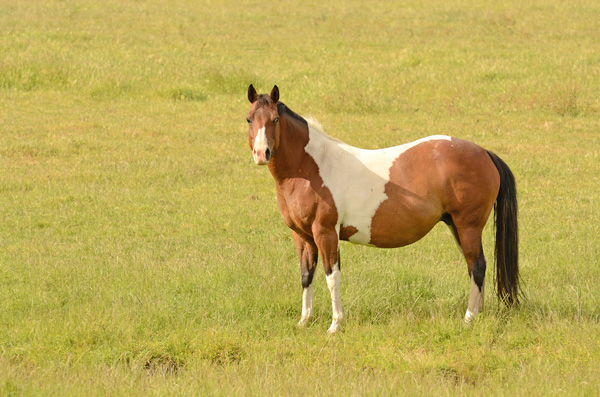
The University of Kentucky College of Agriculture has an outstanding reproductive research staff, and they are constantly looking for the causes of low fertility or infertility in stallions and mares. One problem that is sometimes found is when a horse is genotypically one sex and phenotypically (appearance) another sex. In this article they will look at mares that have XY chromosome problems.
Fertility issues in the horse can stem from multiple causes. One cause in mares is due to a disorder of sexual development (DSD) whereby the sex chromosome complement (genotype, or genetic code) is abnormal and does not agree with the external appearance of the horse (phenotype, or observable characteristics). One common DSD observed in horses occurs when the phenotype is female, but the genotype is male. These horses are called XY mares and have a disorder known as XY DSD (or XY sex reversal). Most of them exhibit the absence of estrous cycles and abnormalities in the reproductive tract such as small, inactive ovaries. These signs are clues for the veterinarian to recommend a chromosomal analysis.
The Molecular Cytogenetics Laboratory at the University of Kentucky’s Maxwell H. Gluck Equine Research Center offers equine practitioners chromosomal analysis service to diagnose DSD. Veterinarians submit blood samples for cytogenetic (chromosome) testing. The white blood cells are cultured and treated with various chemicals, fixed on a microscope slide and stained. The chromosomes from those cells are imaged using a microscope equipped with a camera attached to a computer. Computer software facilitates chromosome identification and placement into a diagram called a karyotype. Analysis of the karyotype reveals any abnormalities in the number and morphology (shape) of the chromosomes.
Horses have 64 chromosomes, including 31 pairs called autosomes, plus two sex chromosomes: two X chromosomes in females and one X and one Y chromosome in males. But in XY mares, the karyotype shows one X and one Y chromosome. That is, the outward female appearance of these horses belies the fact that, genetically, these “mares” are male.
Other types of DSD include horses with only one X chromosome (XO mares) as well as individuals that, despite having two X chromosomes, are male-like in appearance. All of these horses are infertile.
While the karyotype explains the XY mares’ abnormalities, it does not reveal why these horses did not develop as males even though they have a Y chromosome. To answer that question, the lab uses genetic techniques to compare the XY mare’s Y chromosome to that of a normal male horse. Results indicate the Y chromosomes of the XY mares studied are missing a large region (a deletion) that includes a gene called SRY, which is essential in mammalian male development.
The SRY (sex-determining region on the Y) gene produces a protein that, in the male embryo, initiates a series of events leading to development of testes. Without this critical gene, the XY mares develop as infertile females rather than normal males. Further molecular testing can identify this Y chromosome deletion.
Over the years, the Molecular Cytogenetics Laboratory has confirmed some form of DSD in 36% of the samples submitted from horses that exhibit DSD symptoms, with XY mares being the most common form. DSD has been observed in many horse breeds, including Thoroughbreds, Arabians, Belgians, Quarter Horses, Oldenburgs, Tennessee Walking Horses and Standardbreds.
The value of the initial karyotype in diagnosing these disorders is immense. With it, veterinarians and horse owners can make informed decisions about future care and use of affected horses. However, there are still unanswered questions in the realm of XY DSD in horses. What mechanism accounts for this deletion in the Y chromosome? What is the prevalence of this disorder and other DSDs in the general horse population? As the Molecular Cytogenetics Laboratory studies more affected horses using cytogenetic and genetic methods, the picture will become clearer.


